![[Portico of Octavia] Veduta dei Portici d'Ottavia.](img-thumbnail/jpegs/51561.jpg)
[Portico of Octavia] Veduta dei Portici d'Ottavia.
Rossini dis. e inc.
Roma 1820.
Etching. 400 x 460mm (15¾ x 18"), with large margins, uncut.
The Portico of Octavia (Octavia the Younger, 69–11 BC, sister of Augustus), a colonnaded walkway around the temples of Jupiter Stator and Juno Regina, originally built by Augustus, but rebuilt twice during Imperial times. At the time of this scene it was a fish market and formed part of the walls of the Roman Ghetto. The first state, before the plate number, issued unbound. From an early 19th century folder titled 'Roman Engravings. The Property of Major E.G.G. Rugdon[?]'.
[Ref: 51561] £400.00
![[Portico of Octavia] Veduta di Fianco dei Portici d'Ottavia, oggi S.Angelo in Pescharia.](img-thumbnail/jpegs/51549.jpg)
[Portico of Octavia] Veduta di Fianco dei Portici d'Ottavia, oggi S.Angelo in Pescharia.
Rossini dis. e inc.
Roma 1819.
Etching. 465 x 360mm (18¼ x 14¼"), with large margins, uncut.
The side of the Portico of Octavia (Octavia the Younger, 69–11 BC, sister of Augustus), a colonnaded walkway around the temples of Jupiter Stator and Juno Regina, as well as a library, originally built by Augustus, but rebuilt twice during Imperial times. At the time of this scene it was a fish market and formed part of the walls of the Roman Ghetto. The first state, before the plate number, issued unbound. From an early 19th century folder titled 'Roman Engravings. The Property of Major E.G.G. Rugdon[?]'.
[Ref: 51549] £400.00
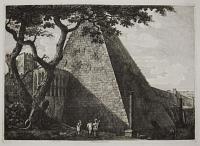
Veduta della Piramide di C. Cestio presa nell'Viale che conduce alla Porta di S.Paolo.
Rossini dis. e inc.
Roma 1822.
Etching. 435 x 605mm (17 x 23¾"), with large, uncut margins.
A brick pyramid faced with marble, built about 18–12 BC as a tomb for Gaius Cestius, a magistrate who probably served in the Roman army in Egypt. Having been incorporated into the Aurelian Wall the pyramid was preserved; a larger one was dismantled in the C16th by Pope Alexander VI and the marble was used for the steps of St. Peter's Basilica. The first state, before the plate number, issued unbound. From an early 19th century folder titled 'Roman Engravings. The Property of Major E.G.G. Rugdon[?]'.
[Ref: 51501] £750.00
![[Quirinal] Veduta Generale del Monte Quirinale dal volgo Monte Cavallo.](img-thumbnail/jpegs/51500.jpg)
[Quirinal] Veduta Generale del Monte Quirinale dal volgo Monte Cavallo.
Rossini dis. e inc.
Roma 1822.
Etching. 440 x 705mm (17¼ x 27¾"), with large, uncut margins. Slight creasing.
View from the Quirinal Hill looking across Rome past the statues of horse tamers (Castor and Pollux) and the obelisk from the Mausoleum of Augustus. The dome of St Peter's is in the centre. The first state, before the plate number, issued unbound. From an early 19th century folder titled 'Roman Engravings. The Property of Major E.G.G. Rugdon[?]'.
[Ref: 51500] £900.00
![[Quirinal] Veduta Generale dei Gran Colossi sul Monte Quirinale.](img-thumbnail/jpegs/31867.jpg)
[Quirinal] Veduta Generale dei Gran Colossi sul Monte Quirinale.
Rossini dis. e inc.
Roma 1819.
Etching with large margins, platemark 365 x 465mm (14¼ x 18¼"). Slight creasing.
View of the Piazza di Monte Cavallo atop the Monte del Quirinale in Rome, with the statues of horse tamers (Castor and Pollux) and Egyptian obelisk. The Palazzo del Quirinale, official residence of the Italian president, overlooks the Piazza. The second state, with plate number.
[Ref: 31867] £220.00
(£264.00 incl.VAT)
![[Quirinal] Veduta Generale dei Gran Colossi sul Monte Quirinale.](img-thumbnail/jpegs/51487.jpg)
[Quirinal] Veduta Generale dei Gran Colossi sul Monte Quirinale.
Rossini dis. e inc.
Roma 1819.
Etching. 365 x 465mm (14¼ x 18¼"), with wide, uncut margins. Slight creasing.
View from the Piazza di Monte Cavallo atop the Monte del Quirinale in Rome, with the statues of horse tamers (the Dioscuri, Castor and Pollux) and the obelisk from the Mausoleum of Augustus. The Palazzo del Quirinale, official residence of the Italian president, overlooks the Piazza. The first state, before the plate number, issued unbound. From an early 19th century folder titled 'Roman Engravings. The Property of Major E.G.G. Rugdon[?]'.
[Ref: 51487] £900.00
![[Saint Paul Outside the Walls.]](img-thumbnail/jpegs/51486.jpg)
[Saint Paul Outside the Walls.] Rovina della gran Basilica di S. Paolo fuori le mura accaduta li 15 Luglio 1823.
Rossini dis. e inc.
Roma 1823.
Etching. 470 x 650mm (18½ x 25½"), with very large, uncut margins. A little wear to the left edge,
A record of the catastrophic fire that destroyed the 1400-year-old Basilica of Saint Paul Outside the Walls in 1823, started by a workman repairing the lead of the roof. Pope Leo XII appealed for help for reconstruction and was answered by donors including the Viceroy of Egypt and the Tsar of Russia; a replica building was opened in 1840. The fire was a major incident: Rossini dedicated four of the 101 plates of his 'Veduta' to the ruins. The first state, before the plate number, issued unbound. From an early 19th century folder titled 'Roman Engravings. The Property of Major E.G.G. Rugdon[?]'.
[Ref: 51486] £750.00
![[Saint Paul Outside the Walls] Veduta della rovina del gran Arco trionfale della nave traversa, ove e la Confessione di S.Paolo fuori le mura.](img-thumbnail/jpegs/51513.jpg)
[Saint Paul Outside the Walls] Veduta della rovina del gran Arco trionfale della nave traversa, ove e la Confessione di S.Paolo fuori le mura.
Rossini dis. e inc.
Roma 1823.
Etching. 495 x 595mm (19½ x 23½"), with large margins, uncut.
View of the interior of the Basilica Papale di San Paolo fuori le Mura (the Papal Basilica of St Paul Outside the Walls), showing the nave, the back of the church and the remains of Arnolfo di Cambio's tabernacle (1285) In 1823 a fire caused by a workman repairing the lead roof destroyed the building. Pope Leo XII appealed for help for reconstruction and was answered by donors including the Viceroy of Egypt and the Tsar of Russia (who gave malachite and lapis lazuli for the tabernacle); a replica building was opened in 1840. The fire was a major incident: Rossini dedicated four of the 101 plates of his 'Veduta' to the ruins. This again is a view of the ruins of The first state, before the plate number, issued unbound. From an early 19th century folder titled 'Roman Engravings. The Property of Major E.G.G. Rugdon[?]'.
[Ref: 51513] £750.00
![[Saint Paul Outside the Walls] Terza Veduta della rovina della gran Basilica di S. Paolo Suori le Mura,](img-thumbnail/jpegs/51505.jpg)
[Saint Paul Outside the Walls] Terza Veduta della rovina della gran Basilica di S. Paolo Suori le Mura, e principalmente del muro della gran nave di mezzo aquasi tutto atterrato delle fumme, dell'incendio accaduto li 15 Luglip 1823.
Rossini dis & inc.
Roma 1823.
Etching. 500 x 570mm (19¾ x 22½"), with very large margins on three sides, uncut.
View of the interior of the Basilica Papale di San Paolo fuori le Mura (the Papal Basilica of St Paul Outside the Walls), shortly after a fire, caused by a workman who was repairing the lead of the roof, destroyed the building. Pope Leo XII appealed for help for reconstruction and was answered by donors including the Viceroy of Egypt and the Tsar of Russia; a replica building was opened in 1840. The fire was a major incident: Rossini dedicated four of the 101 plates of his 'Veduta' to the ruins. The first state, before the plate number, issued unbound. From an early 19th century folder titled 'Roman Engravings. The Property of Major E.G.G. Rugdon[?]'.
[Ref: 51505] £750.00
![[Sant'Urbano alla Caffarella] Veduta dell' Antico Tempio dedicato alle Novo Muse da M. Fulvio Nobiliore](img-thumbnail/jpegs/51542.jpg)
[Sant'Urbano alla Caffarella] Veduta dell' Antico Tempio dedicato alle Novo Muse da M. Fulvio Nobiliore __in oggi S.Urbano fuori di Porta Capena, due miglia.
Rossini dis. e inc.
Roma 1823.
Etching. 400 x 530mm (21 x 15¾"), with large margins, uncut.
Although described by Rossini as a Temple of the Muses, it is now believed the original building was a tomb or a temple dedicated to Faustina, wife of Antoninus Pius (emperor from 138-161). After it became a church dedicated to Sant'Urbano in the C10th its remote location (now on the edge of Caffarella Park) meant it was often abandoned. It was acquired by the city of Rome in 2002 and restored again. The first state, before the plate number, issued unbound. From an early 19th century folder titled 'Roman Engravings. The Property of Major E.G.G. Rugdon[?]'.
[Ref: 51542] £600.00
![[Santa Maria dè Calderari] Unici avanzi dei Portici di Filippo. a S. Maria in Cacaberis.](img-thumbnail/jpegs/5153.jpg)
[Santa Maria dè Calderari] Unici avanzi dei Portici di Filippo. a S. Maria in Cacaberis.
Rossini dis. e inc.
Roma 1822.
Etching. 460 x 365mm (18 x 14½").
A Roman doorway flanked by Doric columns, beside what was Santa Maria dè Calderari, the first church in Rome dedicated to the Immaculate Conception. 'Calderari' refers to the main industry of the local parish, making cauldrons and saucepans; 'Cacaberis' is a slang variation. Although the church was demolished in 1881 during the building the Via Arenula, the doorway still exists in 'Via di Santa Maria dè Calderari'. In front of the doorway is a little scene of street musicians, drawn by Bartolomeo Pinelli to add life to Rossini's architecture.
[Ref: 5153] £150.00
(£180.00 incl.VAT)
![[Santa Maria dè Calderari] Unici avanzi dei Portici di Filippo. a S. Maria in Cacaberis.](img-thumbnail/jpegs/51550.jpg)
[Santa Maria dè Calderari] Unici avanzi dei Portici di Filippo. a S. Maria in Cacaberis.
Rossini dis. e inc.
Roma 1822.
Etching. 460 x 365mm (18 x 14½"), with large margins, uncut.
A Roman doorway flanked by Doric columns, beside what was Santa Maria dè Calderari, the first church in Rome dedicated to the Immaculate Conception. 'Calderari' refers to the main industry of the local parish, making cauldrons and saucepans; 'Cacaberis' is a slang variation. Although the church was demolished in 1881 during the building the Via Arenula, the doorway still exists in 'Via di Santa Maria dè Calderari'. In front of the doorway is a little scene of street musicians, drawn by Bartolomeo Pinelli to add life to Rossini's architecture. The first state, before the plate number, issued unbound. From an early 19th century folder titled 'Roman Engravings. The Property of Major E.G.G. Rugdon[?]'.
[Ref: 51550] £400.00
![[Tarpeian Rock] Veduta degl' Avanzi della Rupe Tarpeja.](img-thumbnail/jpegs/5159.jpg)
[Tarpeian Rock] Veduta degl' Avanzi della Rupe Tarpeja.
Rossini dis. e inc.
Roma 1823.
Etching. 540 x 390mm (21¼ x 15½").
This plate shows part of the Capitoline Hill which is thought to be the Tarpeian Rock, form which criminals were hurled to their death.
[Ref: 5159] £280.00
(£336.00 incl.VAT)
![[Tarpeian Rock] Veduta degl' Avanzi della Rupe Tarpeja.](img-thumbnail/jpegs/51508.jpg)
[Tarpeian Rock] Veduta degl' Avanzi della Rupe Tarpeja.
Rossini dis. e inc.
Roma 1823.
Etching. 540 x 390mm (21¼ x 15½"), with large margins, uncut. With some creasing in the top left corner
The Tarpeian Rock, a cliff on the south side of the Capitoline Hill, from which criminals were hurled to their death if their crimes were deemed shameful. The first state, before the plate number, issued unbound. From an early 19th century folder titled 'Roman Engravings. The Property of Major E.G.G. Rugdon[?]'.
[Ref: 51508] £500.00
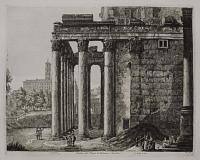
Veduta del Tempio di Antonino, e Faustina..~
Rossini dis. e inc.
Roma 1821.
Etching. 360 x 460mm (14¼ x 18¼"), with large margins, uncut.
The Temple of Antoninus and Faustina in the Roman Rorum, dedicated to Antonius Pius (emperor from 138 to 161) and his consort Faustina. Although the building was given a baroque façade in the 16th century the original pronaos of 56ft columns still survives. The first state, before the plate number, issued unbound. From an early 19th century folder titled 'Roman Engravings. The Property of Major E.G.G. Rugdon[?]'.
[Ref: 51538] £600.00

Ristavro del Tempio della Fortuna Prenestina.
Rossini dis. e inc.
Roma 1826.
Etched plan, 690 x 520mm. 27¼ x 20½". Tear into title at top of plate.
Principal elevations and plan with key text, showing the excavations and restoration to the Santuario della Fortuna Primigenia, a large archaeological site at Palestrina, Rome. Numbered 'T.69' lower right. From 'Le Antichita` dei contorni di Roma ossia le piu` famose citta` del Lazio' by Luigi Rossini (1790 - 1857).
[Ref: 13120] £230.00
(£276.00 incl.VAT)
![[Temple of Hadrian] Veduta dell'avanzo del fianco del Portico, che circondava la Cella del Tempio di Antonino Pio, in oggi Dogana di Terra, e Piazza di Pietra.](img-thumbnail/jpegs/51524.jpg)
[Temple of Hadrian] Veduta dell'avanzo del fianco del Portico, che circondava la Cella del Tempio di Antonino Pio, in oggi Dogana di Terra, e Piazza di Pietra.
Rossini dis. e inc.
Roma 1822.
Etching. 400 x 540mm (15¾ x 21¼"), with large margins, uncut.
The Temple of Hadrian (or Hadrianeum), was built by Antoninus Pius, his adopted son and successor. The wall of the cella and eleven columns of the right side were incorporated into a 17th-century papal palace by Carlo Fontana, and is the home of the Borsa Italiana, Italy's main stock exchange. The first state, before the plate number, issued unbound. From an early 19th century folder titled 'Roman Engravings. The Property of Major E.G.G. Rugdon[?]'.
[Ref: 51524] £900.00
![[Temple of Hercules Victor] Veduta del Tempio di Vesta.](img-thumbnail/jpegs/51492.jpg)
[Temple of Hercules Victor] Veduta del Tempio di Vesta.
Rossini dis. e inc.
Roma 1820.
Etching. 460 x 365mm (18 x 14½"), with large, uncut margins.
The Temple of Hercules Victor in the Foro Boario which, because it is a 'tholos' (a round temple with an external colonnade) was mis-identified as a Temple of Vesta. Built at the end of the 2nd century BC, it is earliest surviving marble building in Rome, although the tile roof is a later replacement. Also named in the key are the Temple of Portunus and the Casa di Rienzi, the supposed home of Cola di Rienzo (1313-54), a populist politician. The first state, before the plate number, issued unbound. From an early 19th century folder titled 'Roman Engravings. The Property of Major E.G.G. Rugdon[?]'.
[Ref: 51492] £600.00
![[Temple of Hercules Victor] Interno del Pronao del Tempio di Vesta, in Roma.](img-thumbnail/jpegs/51534.jpg)
[Temple of Hercules Victor] Interno del Pronao del Tempio di Vesta, in Roma.
Rossini dis. e inc.
Roma 1819.
Etching. 470 x 370mm (18½ x 14½"), with large margins, uncut.
A view under the colonnade of the Temple of Hercules Victor in the Foro Boario which, because it is a 'tholos' (a round temple with an external colonnade) was mis-identified as a Temple of Vesta. Built at the end of the 2nd century BC, it is earliest surviving marble building in Rome, although the tile roof is a later replacement. The first state, before the plate number, issued unbound. From an early 19th century folder titled 'Roman Engravings. The Property of Major E.G.G. Rugdon[?]'.
[Ref: 51534] £600.00
![[Temple of Mars Ultor] Avanzi del Tempio di Marte vindicatore. dal volgo arco de Pantani~](img-thumbnail/jpegs/51558.jpg)
[Temple of Mars Ultor] Avanzi del Tempio di Marte vindicatore. dal volgo arco de Pantani~
Rossini dis. e inc.
Roma 1820.
Etching. 545 x 445mm (21½ x 17¾"), with large margins, uncut.
The three Corinthian columns of the Temple of Mars Ultor and the tower of the Basilian basilica, with the Arco de' Pantani leading out of the Forum of Nerva. The first state, before the plate number, issued unbound. From an early 19th century folder titled 'Roman Engravings. The Property of Major E.G.G. Rugdon[?]'.
[Ref: 51558] £400.00
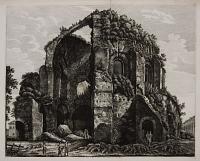
Avanzo del Tempio di Minerva Medica, da altri un sepolcro, vicino a Porta Maggiore.
Rossini dis. e inc.
Roma 1823.
Etching. 500 x 615mm (19¾ x 24¼"), with large, uncut margins. Repaired tear in the top margin, entering image.
Although still known as The Temple of Minerva Medica, it is a 4th century nymphaeum, a building devoted to the nymphs, connected to the nearby Aqua Claudia. It is a ten-sided brick building with a door in one side and recesses with arched windows above on the other nine sides and with a cement cupola, which collapsed five years after Rossini drew it. The first state, before the plate number, issued unbound. From an early 19th century folder titled 'Roman Engravings. The Property of Major E.G.G. Rugdon[?]'.
[Ref: 51504] £450.00
![[Temple of Fortunus] Veduta del Tempio Della Fortuna Virile, oggi S. Maria Egiziaca degli Armeni.](img-thumbnail/jpegs/51535.jpg)
[Temple of Fortunus] Veduta del Tempio Della Fortuna Virile, oggi S. Maria Egiziaca degli Armeni.
Rossini dis. e inc.
Roma 1822.
Etching. 400 x 545mm (15¾ x 21½"), with large margins, uncut.
The Temple of Portunus, the god of the harbours, built in the Forum Boarium in the second century BC. It is one of the best preserved of all Roman temples, mainly because it was converted in 872, becoming the church of Santa Maria Egiziaca (Mary of Egypt, patron saint on penitants). The first state, before the plate number, issued unbound. From an early 19th century folder titled 'Roman Engravings. The Property of Major E.G.G. Rugdon[?]'.
[Ref: 51535] £600.00
![[Temple of Romulus] Veduta del Tempio di Remo nel Foro Romano.](img-thumbnail/jpegs/51562.jpg)
[Temple of Romulus] Veduta del Tempio di Remo nel Foro Romano.
Rossini dis. e inc.
Roma 1820.
Etching. 470 x 370mm (18½ x 14½"), with large margins, uncut.
The Temple of Divus Romulus, along the Via Sacra in the Roman Forum. Valerius Romulus, son of Emperor Maxentius, was consul in AD 308 and 309, and was deified when he died in 309. It is now the basilica of Santi Cosma e Damiano. The bronze doors are the originals of the 4th century, with a lock that still works; the two columns are porphyry columns; the entablature was taken from another classical building and has now been removed. The first state, before the plate number, issued unbound. From an early 19th century folder titled 'Roman Engravings. The Property of Major E.G.G. Rugdon[?]'.
[Ref: 51562] £400.00
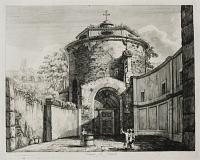
Tempio di Romolo in oggi S. Theodoro.
Rossini dis. e inc.
Roma 1819.
Etching. 365 x 460mm (14¼ x 18"), with large margins, uncut.
The Temple of Divus Romulus, along the Via Sacra in the Roman Forum. Valerius Romulus, son of Emperor Maxentius, was consul in AD 308 and 309, and was deified when he died in 309. Although Rossini calls it the church of Saint Theodorus, it is now the basilica of Santi Cosma e Damiano. The first state, before the plate number, issued unbound. From an early 19th century folder titled 'Roman Engravings. The Property of Major E.G.G. Rugdon[?]'.
[Ref: 51546] £400.00
![[Temple of Saturn] Avanzi del Tempio della Concordia.~](img-thumbnail/jpegs/51526.jpg)
[Temple of Saturn] Avanzi del Tempio della Concordia.~
Rossini dis. e inc.
Roma 1819.
Etching. 460 x 365mm (18 x 14½"), with large margins, uncut.
An oblique view of the porch of the enormous temple, in the west end of the Forum of Rome. In the background is a 44-foot fluted Corinthian column, dedicated to the Eastern Roman Emperor Phocas in 608, who was overthrown two years later. The first state, before the plate number, issued unbound. From an early 19th century folder titled 'Roman Engravings. The Property of Major E.G.G. Rugdon[?]'.
[Ref: 51526] £600.00
![[Temple of Serapis.] Veduta dei grandiosissimi avanzi del Tempio di Giove, dal volgo il frontespizio di Nerone, sul Monte Quirinale, negl' Orti Colonna.](img-thumbnail/jpegs/51548.jpg)
[Temple of Serapis.] Veduta dei grandiosissimi avanzi del Tempio di Giove, dal volgo il frontespizio di Nerone, sul Monte Quirinale, negl' Orti Colonna.
Rossini dis. e inc.
Roma 1820.
Etching. 360 x 455mm (14¼ x 18"), with large margins, uncut. Crease in the centre.
The ruins of the Temple of Serapis on the Quirinal Hill, torn down during the persecution of pagans in the late Empire, with most of the structure reused on other buildings. The first state, before the plate number, issued unbound. From an early 19th century folder titled 'Roman Engravings. The Property of Major E.G.G. Rugdon[?]'.
[Ref: 51548] £600.00
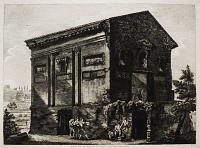
Veduta del Tempio Delle Camene, da Altri del Dio Ridicolo___fuori di Porta Latina nella Valle Della Caffarella.
Rossini dis. e inc.
Roma 1823.
Etching. 460 x 615mm (18 x 24¼"), with large margins, uncut. Tear just touching plate at bottom.
A building in the Park of the Caffarella, possibly the tomb of Aspasia Annia Regilla, wife of Herodes Atticus, once owner of the estate. Rossini attributed the building to either the Temple of the Camenae (four goddesses of childbirth, wells and fountains) or the Temple of the God Rediculum (the god that Romans honoured at the beginning and end of each journey). It is believed to be the spot where Hannibal turned back from Rome. The first state, before the plate number, issued unbound. From an early 19th century folder titled 'Roman Engravings. The Property of Major E.G.G. Rugdon[?]'.
[Ref: 51539] £600.00

Veduta del Tempio Delle Camene, da Altri del Dio Ridicolo___fuori di Porta Latina nella Valle Della Caffarella.
Rossini dis. e inc.
Roma 1823.
Etching. 460 x 615mm (18 x 24¼").
A building in the Park of the Caffarella, possibly the tomb of Aspasia Annia Regilla, wife of Herodes Atticus, once owner of the estate. Rossini attributed the building to either the Temple of the Camenae (four goddesses of childbirth, wells and fountains) or the Temple of the God Rediculum (the god that Romans honoured at the beginning and end of each journey). It is believed to be the spot where Hannibal turned back from Rome.
[Ref: 5168] £350.00
![[Temple of the Dioscuri] Avanzi del Tempio di Giove Statore nel Foro Romano.](img-thumbnail/jpegs/51528.jpg)
[Temple of the Dioscuri] Avanzi del Tempio di Giove Statore nel Foro Romano.
Rossini dis. e inc.
Roma 1821.
Etching. 460 x 390mm (18 x 15¼"), with large margins, uncut.
Rather than being the Temple of Jove, these are the remains of the Temple of the Dioscuri (Castor and Pollux) in the Roman Forum. First built in 494BC, it was restored many times, so these columns date from the temple, dedicated by Tiberias in 6AD. The Dioscuri were the patrons of the Knights who every year held an impressive parade outside the temple. Under the columns is a little scene of riders driving bulls through the forum, drawn by Bartolomeo Pinelli to add life to Rossini's architecture. The first state, before the plate number, issued unbound. From an early 19th century folder titled 'Roman Engravings. The Property of Major E.G.G. Rugdon[?]'.
[Ref: 51528] £750.00
![[Temple of Venus & Rome] Veduta Generale del Tempio di Venere, e Roma.](img-thumbnail/jpegs/51554.jpg)
[Temple of Venus & Rome] Veduta Generale del Tempio di Venere, e Roma.
Rossini dis. e inc.
Roma 1821.
Etching. 375 x 540mm (14¾ x 21¼"), with large margins, uncut.
The Temple of Venus and Rome on the Velian Hill, between the eastern edge of the Forum Romanum and the Colosseum. A double temple (having two apses back to back, one dedicated to each deity), it was built by Hadrian, probably to his own design, and dedicated in AD 135. It is believed to be have been the largest temple in Rome. The first state, before the plate number, issued unbound. From an early 19th century folder titled 'Roman Engravings. The Property of Major E.G.G. Rugdon[?]'.
[Ref: 51554] £600.00
![[Theatre of Marcellus] Avanzi del Teatro di Marcello.](img-thumbnail/jpegs/51540.jpg)
[Theatre of Marcellus] Avanzi del Teatro di Marcello.
Rossini dis. e inc.
Roma 1821.
Etching. 415 x 510mm (16¼ x 20"), with large margins, uncut.
The Theatre of Marcellus was started by Julius Caesar and completed by Augustus in 13 BC, who dedicated to his heir Marcellus who had died aged 20. It was an enormous building, 115 ft. high and 127 ft. in diameter, capable of holding 15,000 people. The first state, before the plate number, issued unbound. From an early 19th century folder titled 'Roman Engravings. The Property of Major E.G.G. Rugdon[?]'.
[Ref: 51540] £750.00
![[The banks of the Tiber] Veduta dell' Antiche sostruzioni fatto da Tarquino, dette il bel Lido,](img-thumbnail/jpegs/51488.jpg)
[The banks of the Tiber] Veduta dell' Antiche sostruzioni fatto da Tarquino, dette il bel Lido, e da altri, da Marco Agrippa à tempi di Augusto quando ripurgò le Cloache sino di Tevere.
Rossini dis. e inc.
Roma 1823.
Etching. 420 x 650mm (16½ x 25½"), with large margins, uncut. Tears and creasing to margins top and right.
A view of the banks of the Tiber near the Foro Boario, before the modern embankment. In the centre of the plate ('A' in the key) is the outflow of the Cloaca Maxima, one of the world's first sewers, supposedly built by Tarquinius Priscus c.600BC. Above is the Temple of Hercules Victor, the colonnaded circular form of which led it to be misidentified as a Temple of Vesta. The first state, before the plate number, issued unbound. From an early 19th century folder titled 'Roman Engravings. The Property of Major E.G.G. Rugdon[?]'.
[Ref: 51488] £750.00
![[Tiber Island] Veduta Dell' Isola Tiberina.](img-thumbnail/jpegs/51536.jpg)
[Tiber Island] Veduta Dell' Isola Tiberina.
Rossini dis. e inc.
Roma 1820.
Etching. 320 x 460mm (12½ x 18"), with large margins, uncut.
A view of Tiber Island, showing the bank modelled to look like the prow of a ship as homage to the legend of the founding of the temple to Aesculapius, god of medicine, on the island. The highest tower is that of the Basilica of San Bartolomeo all'Isola. The first state, before the plate number, issued unbound. From an early 19th century folder titled 'Roman Engravings. The Property of Major E.G.G. Rugdon[?]'.
[Ref: 51536] £600.00
![[Tomb of Caius Vibius Marianus] Veduta del Gran Sepolcro volgarmente detto di Nerone](img-thumbnail/jpegs/51537.jpg)
[Tomb of Caius Vibius Marianus] Veduta del Gran Sepolcro volgarmente detto di Nerone _ Sulla Via Flaminia, 5. Migla lontano da Roma.~
Rossini dis. e inc.
Roma 1822.
Etching. 565 x 410mm (22¼ x 16"), with large margins, uncut.
The tomb of Caius Vibius Marianus, a pro-consul, five miles outside Rome on the Flavinian Way. Like other classical tombs it is divided in two, the base being plain and strong, the upper part decorative. The first state, before the plate number, issued unbound. From an early 19th century folder titled 'Roman Engravings. The Property of Major E.G.G. Rugdon[?]'.
[Ref: 51537] £750.00
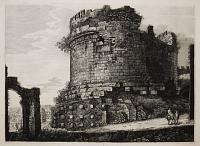
Veduta del Gran Sepulcro di Cecilia Metella. situato nella Via Appia
Rossini dis. e inc.
Roma 1822.
Etching. 460 x 630mm (18 x 24¾"), with very large margins on three sides, uncut. Torn, with some creasing.
The tomb of Cecilia Metella, daughter-in-law of Marcus Crassus the Triumvir, built on the Appian Way c. 20 BC. It has a strong square base from which rises a circular tower (66 ft. in diameter), faced in marble with a frieze of garlands and ox sculls. On the top are medieval battlements, from when the building was used as part of a castrum owned by the Gaetani family. The first state, before the plate number, issued unbound. From an early 19th century folder titled 'Roman Engravings. The Property of Major E.G.G. Rugdon[?]'.
[Ref: 51507] £400.00
![[Tower of Belisarius] Veduta degl' Avanzi delle Torri di Belisario_Dalla parte che guarda l'interno della Citta, vicino a Porta S.Giovanni.](img-thumbnail/jpegs/51552.jpg)
[Tower of Belisarius] Veduta degl' Avanzi delle Torri di Belisario_Dalla parte che guarda l'interno della Citta, vicino a Porta S.Giovanni. T28
Rossini dis. e inc.
Roma 1822.
Etching. 425 x 556mm (16¾" x 21¼"), with large margins, uncut.
A view of the city side of the Tower of Belisarius, built into the Aurelian Walls. In 536 the great general Belisarius took Rome for the Eastern Empire and strengthened the walls against the Ostrogothic counter attack. The first state, before the plate number, issued unbound. From an early 19th century folder titled 'Roman Engravings. The Property of Major E.G.G. Rugdon[?]'.
[Ref: 51552] £600.00
![[Tower of Belisarius] Veduta degl' Avanzi delle Torri di Belisario_Dalla parte che guarda l'interno della Citta, vicino a Porta S.Giovanni.](img-thumbnail/jpegs/26980.jpg)
[Tower of Belisarius] Veduta degl' Avanzi delle Torri di Belisario_Dalla parte che guarda l'interno della Citta, vicino a Porta S.Giovanni. T28
Rossini dis. e inc.
Roma 1822.
Etching. 425 x 556mm (16¾" x 21¼"), with very large margins.
A view of the city side of the Tower of Belisarius, built into the Aurelian Walls. In 536 the great general Belisarius took Rome for the Eastern Empire and strengthened the walls against the Ostrogothic counter attack. The second state, with plate number.
[Ref: 26980] £320.00
![[Trajan's Market] Veduta del secondo Ordine dei Bagni di Paolo Emilio da altri chiamatala Calcidica del Foro Trajano.](img-thumbnail/jpegs/51559.jpg)
[Trajan's Market] Veduta del secondo Ordine dei Bagni di Paolo Emilio da altri chiamatala Calcidica del Foro Trajano.
Rossini dis. e inc.
Roma 1822.
Etching. 365 x 455mm (14½ x 18"), with large margins, uncut.
Trajan's Market, on the Via dei Fori Imperiali, probably built in 100-110 AD by Apollodorus of Damascus, is believed to be the world's oldest shopping mall. The first state, before the plate number, issued unbound. From an early 19th century folder titled 'Roman Engravings. The Property of Major E.G.G. Rugdon[?]'.
[Ref: 51559] £600.00
![[Portico of Octavia] Veduta dei Portici d'Ottavia.](img-thumbnail/jpegs/51561.jpg)
![[Portico of Octavia] Veduta di Fianco dei Portici d'Ottavia, oggi S.Angelo in Pescharia.](img-thumbnail/jpegs/51549.jpg)

![[Quirinal] Veduta Generale del Monte Quirinale dal volgo Monte Cavallo.](img-thumbnail/jpegs/51500.jpg)
![[Quirinal] Veduta Generale dei Gran Colossi sul Monte Quirinale.](img-thumbnail/jpegs/31867.jpg)
![[Quirinal] Veduta Generale dei Gran Colossi sul Monte Quirinale.](img-thumbnail/jpegs/51487.jpg)
![[Saint Paul Outside the Walls.]](img-thumbnail/jpegs/51486.jpg)
![[Saint Paul Outside the Walls] Veduta della rovina del gran Arco trionfale della nave traversa, ove e la Confessione di S.Paolo fuori le mura.](img-thumbnail/jpegs/51513.jpg)
![[Saint Paul Outside the Walls] Terza Veduta della rovina della gran Basilica di S. Paolo Suori le Mura,](img-thumbnail/jpegs/51505.jpg)
![[Sant'Urbano alla Caffarella] Veduta dell' Antico Tempio dedicato alle Novo Muse da M. Fulvio Nobiliore](img-thumbnail/jpegs/51542.jpg)
![[Santa Maria dè Calderari] Unici avanzi dei Portici di Filippo. a S. Maria in Cacaberis.](img-thumbnail/jpegs/5153.jpg)
![[Santa Maria dè Calderari] Unici avanzi dei Portici di Filippo. a S. Maria in Cacaberis.](img-thumbnail/jpegs/51550.jpg)
![[Tarpeian Rock] Veduta degl' Avanzi della Rupe Tarpeja.](img-thumbnail/jpegs/5159.jpg)
![[Tarpeian Rock] Veduta degl' Avanzi della Rupe Tarpeja.](img-thumbnail/jpegs/51508.jpg)


![[Temple of Hadrian] Veduta dell'avanzo del fianco del Portico, che circondava la Cella del Tempio di Antonino Pio, in oggi Dogana di Terra, e Piazza di Pietra.](img-thumbnail/jpegs/51524.jpg)
![[Temple of Hercules Victor] Veduta del Tempio di Vesta.](img-thumbnail/jpegs/51492.jpg)
![[Temple of Hercules Victor] Interno del Pronao del Tempio di Vesta, in Roma.](img-thumbnail/jpegs/51534.jpg)
![[Temple of Mars Ultor] Avanzi del Tempio di Marte vindicatore. dal volgo arco de Pantani~](img-thumbnail/jpegs/51558.jpg)

![[Temple of Fortunus] Veduta del Tempio Della Fortuna Virile, oggi S. Maria Egiziaca degli Armeni.](img-thumbnail/jpegs/51535.jpg)
![[Temple of Romulus] Veduta del Tempio di Remo nel Foro Romano.](img-thumbnail/jpegs/51562.jpg)

![[Temple of Saturn] Avanzi del Tempio della Concordia.~](img-thumbnail/jpegs/51526.jpg)
![[Temple of Serapis.] Veduta dei grandiosissimi avanzi del Tempio di Giove, dal volgo il frontespizio di Nerone, sul Monte Quirinale, negl' Orti Colonna.](img-thumbnail/jpegs/51548.jpg)


![[Temple of the Dioscuri] Avanzi del Tempio di Giove Statore nel Foro Romano.](img-thumbnail/jpegs/51528.jpg)
![[Temple of Venus & Rome] Veduta Generale del Tempio di Venere, e Roma.](img-thumbnail/jpegs/51554.jpg)
![[Theatre of Marcellus] Avanzi del Teatro di Marcello.](img-thumbnail/jpegs/51540.jpg)
![[The banks of the Tiber] Veduta dell' Antiche sostruzioni fatto da Tarquino, dette il bel Lido,](img-thumbnail/jpegs/51488.jpg)
![[Tiber Island] Veduta Dell' Isola Tiberina.](img-thumbnail/jpegs/51536.jpg)
![[Tomb of Caius Vibius Marianus] Veduta del Gran Sepolcro volgarmente detto di Nerone](img-thumbnail/jpegs/51537.jpg)

![[Tower of Belisarius] Veduta degl' Avanzi delle Torri di Belisario_Dalla parte che guarda l'interno della Citta, vicino a Porta S.Giovanni.](img-thumbnail/jpegs/51552.jpg)
![[Tower of Belisarius] Veduta degl' Avanzi delle Torri di Belisario_Dalla parte che guarda l'interno della Citta, vicino a Porta S.Giovanni.](img-thumbnail/jpegs/26980.jpg)
![[Trajan's Market] Veduta del secondo Ordine dei Bagni di Paolo Emilio da altri chiamatala Calcidica del Foro Trajano.](img-thumbnail/jpegs/51559.jpg)